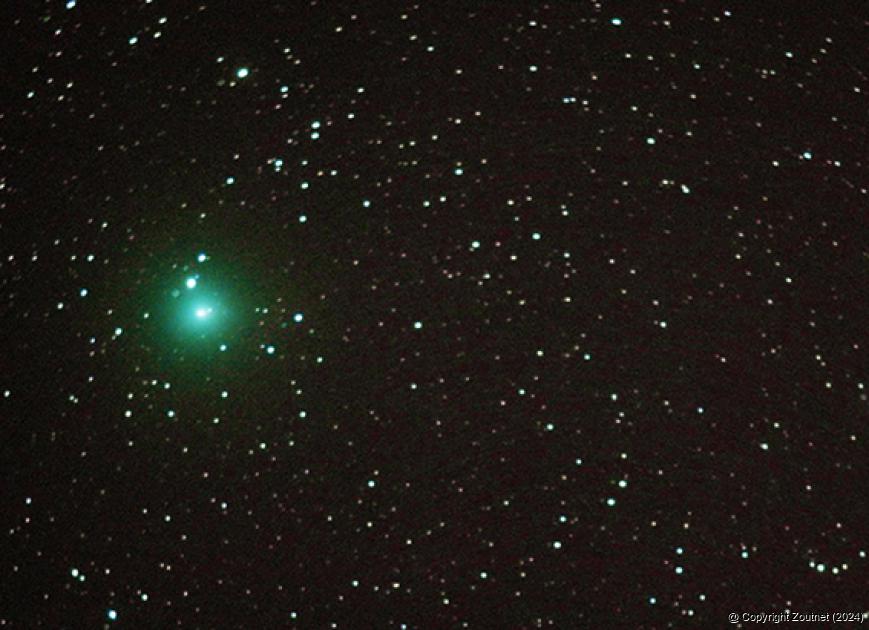

ADVERTISEMENT:

Comet 46P/Wirtanen (46P) or the latest "Christmas Comet" is already visible to the naked eye and will be getting bigger and bigger in the night sky this month. Photo supplied.
Don't be scared - it's just the Christmas comet
This December, an extra light will be visible in the sky, even to the naked eye, when Comet 46P/Wirtanen (46P) makes its closest ever pass by the earth.
Already fondly referred to, by those who take the time to look up, as the Christmas Comet, it is attracting a lot of attention from more than only stargazers.
The Zoutpansberger asked Kos Coronaios, whom residents might remember from the Soutpansberg Astronomy Club and who recently moved to Pearly Beach, to tell readers more about this fast-approaching comet. He obliged.
“Comet 46P/Wirtanen is a small, short-period comet with an orbital period of 5.4 years. Wirtanen makes a very close (for a comet) approach to earth on 16 December, just a few days after perihelion on 12 December. At around 30 lunar distances (11.5 million km) from earth, it’s the 10th closest approach of a comet in modern times. Predictions are that it could reach naked-eye visibility at close approach, with excellent observing conditions.”
Discovered by the astronomer Carl Wirtanen in 1948, 46P is one of what are known as members of the “Jupiter family” of comets, with short orbital periods of 20 years or fewer, with their farthest point from the sun being near to the orbit of Jupiter. These comets can occasionally have their own orbits significantly changed when they approach Jupiter’s powerful gravitational field. Jupiter nudged 46P’s orbit approximately 50 million miles closer to the sun and much closer to earth’s orbit in 1972 and 1984 when it did its Jupiter flypasts. Because of that, the comet will be very visible when it goes by this time.
46P is in fact going to make the 20th closest approach to earth of any known comet since the ninth century and one of the 10 closest since 1950. On 16 December, at around 15:06, which will be four days after it makes its closest ever approach to the sun, 46P will fly by earth at a mere 11 586 350 kilometres away, at a speed of around 33 790.6 kilometres per hour. At this point the comet will become very bright and will certainly be visible to the naked eye.
While 46P is fairly small, as comets go, and unlikely to have much of a tail, its head is expected to appear extremely large and much more impressive to see with the use of binoculars or a telescope. “It already has a dust tail, but I’m not sure about an ion one,” said Kos. “The coma is already bigger than 30 arc minutes. That’s the size of the moon as seen from earth. It consists mainly of dust and gas.”
This is not going to be a spotlight beam, but rather a soft light in the sky, and for once load shedding might be useful if occurring in the hours of darkness, because darkness is exactly what is needed to get a good view of a passing comet. Experts say that this will not happen again as far as 46P is concerned.
When the newspaper asked Kos if it posed any danger to earth, he said: “No danger, and no meteor showers either this time around.” He continued: “At magnitude +5, the comet is easily visible in binoculars, as well as with the naked eye from a reasonably dark sky site [not a light polluted one]. Not quite a Christmas comet in the Terry Lovejoy style, but still a naked-eye one.” According to estimates, the comet is 1.1 kilometres in diameter.
News - Date: 13 December 2018

Recent Articles
-

Community threatens with shutdown if roads are not fixed
18 April 2024 By Elmon Tshikhudo -

Vhembe swyg oor gesloer om lekke reg te maak
18 April 2024 By Andries van Zyl -

Border fence contractors lose appeal to retain profits
18 April 2024 -

New Lukwarani leader may be blind, but has bright vision for his people
14 April 2024 By Elmon Tshikhudo
Search for a story:

ADVERTISEMENT


Jo Robinson
Jo joined the Zoutpansberger and Limpopo Mirror in 2018 pursuing a career in journalism after many years of writing fiction and non-fiction for other sectors.
Email: [email protected]

ADVERTISEMENT:


